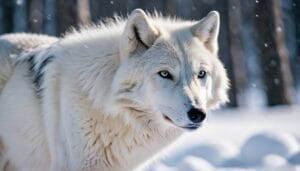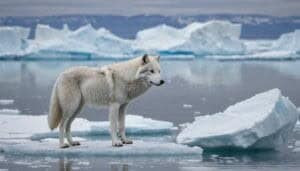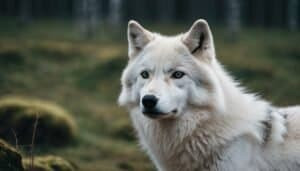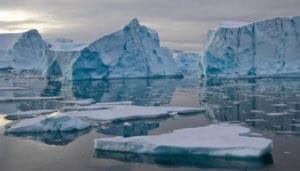Introduction
Arctic wolves, apex predators adapted to the extreme cold of the Arctic tundra, face growing challenges as weather patterns in their habitat change. These changes, driven by global climate shifts, affect their reproduction by disrupting mating cycles, denning behavior, and pup survival rates
Additionally, shifts in prey availability and habitat conditions compound the difficulties for Arctic wolves. This article explores the effects of Arctic weather changes on wolf reproduction, examining the challenges they face and the adaptations they employ to survive in a rapidly evolving environment
The Impact of Arctic Weather Changes on Reproduction
Arctic wolves are highly adapted to the extreme conditions of the tundra, but recent changes in weather patterns are disrupting the delicate balance of their reproductive cycles
From harsher storms to shifting seasonal timelines, these changes impact key aspects of their breeding and denning behavior, as well as the availability of resources necessary for raising pups
Key Weather Changes in the Arctic
The Arctic is experiencing significant and rapid climatic shifts, including rising temperatures, more frequent extreme weather events, and alterations in seasonal snow cover
According to Smith et al. (2021), the average temperature in the Arctic has risen at nearly twice the global rate over the past few decades, resulting in longer summers and shorter, milder winters
These changes disrupt the natural rhythm of the tundra ecosystem. For instance, earlier snowmelt and delayed snowfall can alter the timing of prey availability, directly impacting the breeding success of Arctic wolves
Additionally, the increased frequency of severe storms and unseasonable temperature fluctuations create unpredictable challenges for wolf packs, particularly during their reproductive season
Effects on Arctic Wolf Mating and Denning Behavior
Arctic wolf reproduction is closely tied to seasonal patterns, with mating typically occurring in late winter and pups born in the spring. Changes in weather patterns disrupt this cycle by influencing the availability and condition of denning sites
Warmer temperatures can lead to early thaws, destabilizing traditional den structures dug into snowbanks or permafrost. Hanson et al. (2020) noted that packs forced to relocate their dens due to melting or flooding often experience reduced reproductive success
Additionally, unpredictable weather can delay or advance mating seasons, leading to mismatches between the timing of births and the availability of prey
This misalignment poses a significant challenge for Arctic wolves, as a lack of sufficient food during the critical pup-rearing period can lead to higher mortality rates
Prey Availability and Its Role in Reproductive Success
The reproductive success of Arctic wolves is closely linked to the availability of prey, primarily caribou and muskoxen. Shifts in weather patterns disrupt the migratory behaviors of these prey species, making it more difficult for wolves to find and hunt them efficiently
Johnson and Reed (2019) found that deeper snowpacks in some regions hinder wolf mobility, while thinner snowpacks in others reduce the advantage wolves typically have over their prey
When prey availability declines, wolf packs may struggle to sustain themselves, let alone feed new litters. This nutritional stress can result in smaller litter sizes and lower pup survival rates
Prolonged scarcity of prey can also lead to increased competition among pack members, further straining reproductive efforts
Challenges for Arctic Wolf Pups in a Changing Climate
The survival of Arctic wolf pups is a critical factor in maintaining healthy populations, but shifting weather patterns pose new challenges during their vulnerable early life stages
Changes in snowpack, seasonal timing, and extreme weather events all contribute to increased mortality risks and pressure on wolf packs to adapt
Survival Rates During Extreme Weather
Arctic wolf pups are born in the spring, typically in dens that provide insulation and protection from the elements
However, extreme weather events, such as unseasonable storms or sudden temperature drops, can jeopardize their survival. Heavy rains and early thaws can flood dens, forcing packs to relocate during a time when pups are too young to travel safely
Walker et al. (2018) observed that survival rates for Arctic wolf pups dropped significantly during years with high storm activity
Exposure to the elements during these events increases the likelihood of hypothermia and starvation, particularly if the pack struggles to find sufficient food due to disrupted hunting conditions
Impacts of Snowpack and Seasonal Shifts
Snowpack depth and consistency play a critical role in Arctic wolf reproduction and pup survival. In regions where snowpack is unusually deep, wolves may face difficulty hunting prey, as their movement is hindered while caribou and muskoxen remain relatively unaffected
Conversely, thinner or inconsistent snow can reduce insulation for dens, exposing pups to harsher environmental conditions
Seasonal shifts, such as earlier snowmelts and later freezes, further complicate these dynamics. These changes can shorten the hunting season or misalign the availability of prey with the period when pups require the most nourishment
For example, Green (2022) found that longer summers led to delayed migrations of prey species, leaving wolf packs without access to adequate food during critical pup-rearing months
Adaptations to Unpredictable Weather Patterns
Despite these challenges, Arctic wolves demonstrate remarkable resilience and adaptability. Some packs have been observed altering their denning behavior, choosing locations less prone to flooding or temperature fluctuations
Wolves may also adjust their hunting strategies, targeting smaller or more readily available prey if traditional sources become scarce
However, these adaptations are not always sufficient to offset the broader impacts of climate change. In regions where weather patterns are most unpredictable, wolf populations face increased stress, leading to higher pup mortality and slower recovery rates
Hanson et al. (2020) emphasized the need for continued monitoring to understand how Arctic wolves are responding to these changes and to identify areas where conservation efforts may be most effective
Conservation Implications of Climate Change on Arctic Wolves
The rapid changes in Arctic weather patterns and their effects on Arctic wolf reproduction highlight the need for targeted conservation efforts
Understanding how climate change impacts these apex predators can inform strategies to mitigate risks and support the long-term stability of their populations
The Role of Human Activities in Arctic Weather Shifts
Human-induced climate change is a primary driver of the shifting Arctic weather patterns that affect Arctic wolf reproduction. The burning of fossil fuels, deforestation, and industrial activities contribute to global warming, which is especially pronounced in the Arctic
Rising temperatures lead to the melting of permafrost, reduced snowpack, and disrupted prey migration patterns—all of which cascade into challenges for Arctic wolves
Additionally, increasing human presence in the Arctic, including oil exploration, shipping, and tourism, can exacerbate the stress on wolf populations. Habitat encroachment and noise pollution can disrupt denning behavior and force wolves to abandon otherwise suitable territories
Strategies to Support Arctic Wolf Populations
Conservation efforts must prioritize protecting the Arctic environment to ensure the survival of Arctic wolves
Key strategies include:
Preserving Critical Habitats: Designating protected areas that encompass key hunting grounds and denning sites can help minimize the impact of habitat loss and human disturbance
Mitigating Climate Change: Global efforts to reduce greenhouse gas emissions are crucial for slowing the rate of Arctic warming and preserving the ecosystem
Monitoring Wolf Populations: Establishing long-term studies to track changes in Arctic wolf behavior, reproduction, and population dynamics can provide valuable data for adaptive conservation measures
Supporting Prey Species: Conservation programs that protect caribou and muskoxen, the primary prey of Arctic wolves, indirectly support wolf populations by ensuring a stable food supply
Future Research Needs
While existing studies provide insights into the challenges Arctic wolves face, there is still much to learn about their capacity to adapt to a rapidly changing environment
Key areas for future research include:
Investigating the genetic diversity of Arctic wolf populations to assess their resilience to environmental stressors
Examining how shifts in prey dynamics affect long-term reproductive success
Identifying microhabitats that may serve as refuges from extreme weather events
Collaborative research efforts involving local communities, scientists, and policymakers will be critical for developing holistic strategies to conserve Arctic wolves and their ecosystems
Conclusion
Changes in Arctic weather patterns, driven by global climate change, are profoundly affecting Arctic wolf reproduction
Rising temperatures, unpredictable storms, and shifting snowpack conditions disrupt mating cycles, denning behavior, and prey availability, leading to increased challenges for wolf populations. These disruptions pose significant risks to pup survival and pack stability, threatening the long-term viability of this apex predator
Despite their adaptability, Arctic wolves face mounting pressures as their environment transforms. Conservation efforts must focus on protecting critical habitats, addressing the root causes of climate change, and supporting prey species to stabilize the ecosystem
Ongoing research and collaborative initiatives will play a vital role in developing strategies to mitigate these impacts and preserve Arctic wolves for future generations
As stewards of the environment, humans have a responsibility to ensure that Arctic wolves and their fragile ecosystem can endure in the face of rapid change. By taking action now, we can help secure a future for these iconic predators and the Arctic wilderness they call home











